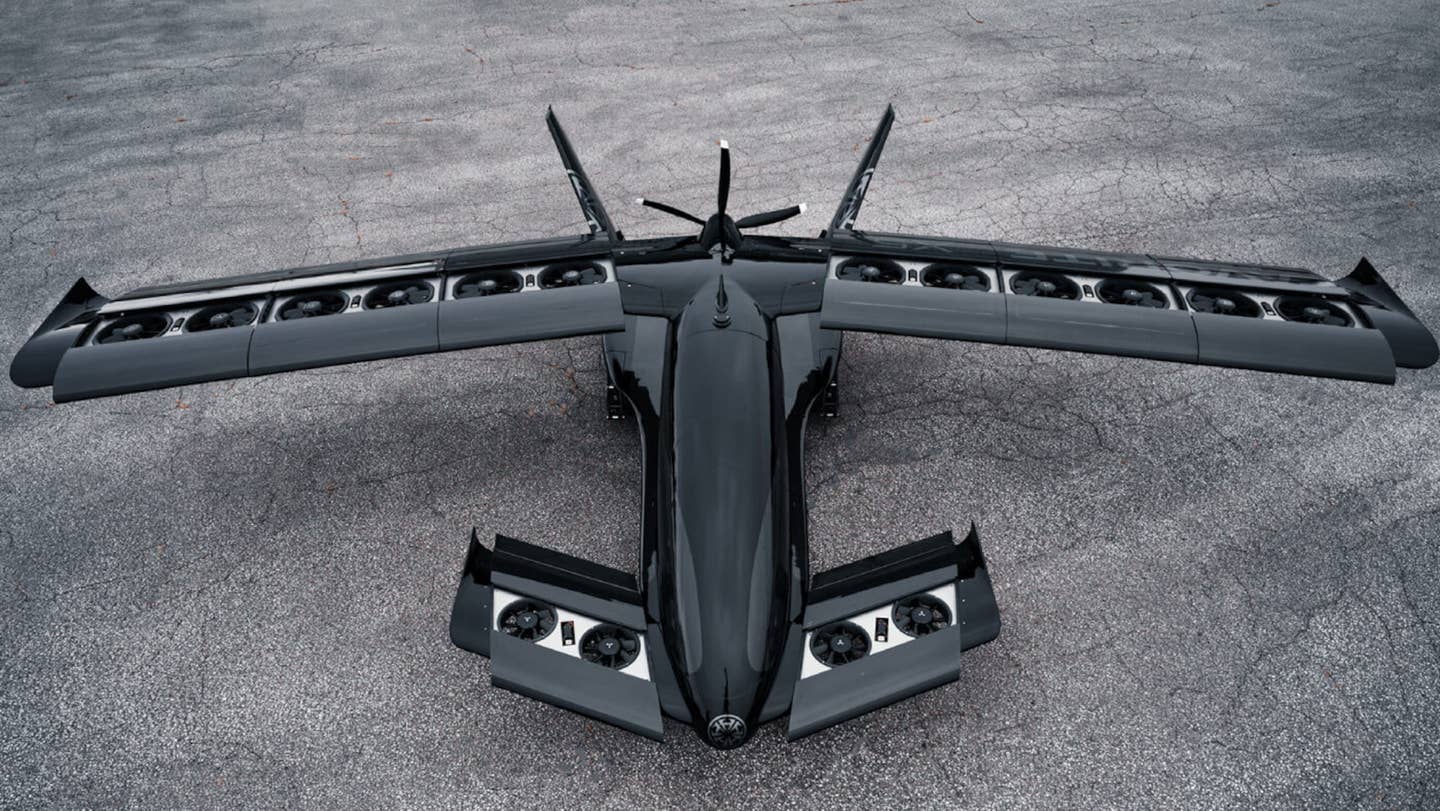Horizon Aircraft Announces Plans for 7-Seat Hybrid eVTOL
The Canadian manufacturer initially set its sights on a five-seat prototype before pivoting to a larger model.

Horizon Aircraft’s Cavorite X5 prototype, which will soon be replaced with a seven-seat model. [Courtesy: Horizon Aircraft]
There’s a new electric vertical takeoff and landing (eVTOL) aircraft design in development. And it claims to be bigger, faster, and roomier than designs from Joby Aviation, Archer Aviation, Lilium, or EHang.
Toronto-based manufacturer Horizon Aircraft on Tuesday revealed that it has improved on the design of its flagship five-seater Cavorite X5—so much so that the firm is pivoting to a new model. Horizon will replace the X5 with the Cavorite X7, a larger, seven-seat version for applications in medical evacuation, critical supply delivery, disaster relief, and military missions.
Horizon also believes its new flagship eVTOL will be ideal for regional air taxi services, like those the aforementioned companies are looking to provide in urban and suburban areas. It’s expected to move people or cargo over distances between 50 and 500 sm (43 to 434 nm), a bit farther than planned air taxi routes from Joby and Delta, Archer and United, and others.
The Canadian company chose to modify its design for a few reasons. Positive flight testing results of the firm’s 50 percent-scale prototype, as well as an internal analysis of its aerodynamics, structure, and electronics, revealed the X5 could be expanded to make room for a pilot and six passengers.
And then there’s the customers. Horizon said clients serving the medical evacuation, business aviation, and commercial cargo industries requested a larger aircraft with lower passenger seat mile costs to better align with their needs.
All of that feedback means the X5 will be short-lived: A first prototype was revealed in August 2022, and initial hover testing began in January. However, the X7 will inherit plenty of its predecessor’s components and features.
“The shift to a seven-seat aircraft has been discussed since the beginning of our hybrid eVTOL initial concept,” said Brandon Robinson, CEO of Horizon. “It’s a size that just makes sense commercially. We are very confident our unique fan-in-wing technology can support this new and larger platform, and our testing results have provided us with confidence that we can potentially scale to an even larger aircraft.”
Both Robinson and his father, Brian, Horizon’s co-founder and chief engineer, are experienced fliers who saw an opportunity to get in on the ground floor of the eVTOL industry.
“Close to 2013, there was a gentleman with the vision of a completely new type of aircraft that was based on our family plane—an RC‑3 Republic Seabee that he and my grandfather built from scrap,” Robinson said in the eVTOL Insights Q&A. “My father had always been interested in electrification—using smaller, lighter, and more reliable electric components in many of his projects. He had the idea to design his new prototype aircraft around a hybrid-electric power system.”
The seven-seater Cavorite will have an estimated gross weight of 5,500 pounds with a useful load of 1,500 pounds. It has a projected 250 mph (217 knots) top speed and a 500 sm (434 nm) maximum range. Notably, the X7 will be able to take off vertically like a helicopter, or conventionally from the runway—the latter would boost its useful load to 1,800 pounds.
According to Horizon, the X7 will use a “patented” configuration in which redundant electric ducted fans are embedded in the wings. However, the Lilium Jet and Doroni H1 have similar fan-in-wing architectures.
While it’s unclear exactly how the fans will be arranged on the X7, Horizon’s X5 placed 12 in the wings and four in the forward canards to provide vertical lift. Meanwhile, a pusher propeller attached to the rear of the fuselage enabled forward flight. Movable surfaces on the wings covered the fans during cruise, increasing lift across the wings and canards.
The X7’s hybrid-electric power system is designed to recharge its battery packs within 30 minutes between missions. But the aircraft would also be able to recharge its batteries in the air when flying like a traditional plane—on its wings, in a very low-drag configuration—using a range extender motor. Horizon claims the X7 will be able to spend 98 percent of its mission time flying this way, making it potentially safer and easier to certify than more complex designs.
While designed to fly on 100 percent electric power, the eVTOL is also built to run on gas. Still, Horizon promises it will cut hydrocarbon emissions in half. The hybrid-electric design is unlike fully electric models from Joby, Archer, Lilium, and EHang, but it gives the X7 a greater range, speed, and useful load than all of them. Among those firms, only Lilium is designing a seven-seater.
“A machine that will do useful work over [31 miles] will probably have a max range on the order of [62 miles] or more, because it must get to its destination, perhaps facing unforecasted headwinds, maybe diverting around bad weather, and then be able to abort a landing and head to an alternate landing area,” Robinson said in a 2021 Q&A with eVTOL Insights. “This requires a lot of energy—more than many purely electric designs will be able to practically handle.”
In that same interview, Robinson characterized Horizon’s design as a “normal” aircraft with eVTOL capabilities, rather than an eVTOL with some features of a traditional airplane.
For now, Horizon will continue to test its half-scale X5 prototype, which it believes will reduce risk when the time comes to develop full-scale X7 models. Already, the company said the design has garnered “significant interest” within the aviation industry. It also cited the new model as the catalyst for securing a handful of Canadian grants and a Department of Defense research and development contract.
In August, Horizon announced its plans to go public via a business combination with special purpose acquisition company (SPAC) Pono Capital Three, about two and a half years after it exited stealth.
Since February, the company has been receiving development and type certification support for the X5 from Cert Center Canada (3C), a Transport Canada-approved, independent flight test and certification design approval organization. 3C has provided certification planning, design consulting, training, flight testing, and airworthiness approval services.
Robinson in the 2021 Q&A said production of the X5 would begin in 2024 and focus on low-volume manufacturing in order to refine the design and enable scale in the future at a lower cost. So far, no timeline has been announced for the new X7.
Like this story? We think you'll also like the Future of FLYING newsletter sent every Thursday afternoon. Sign up now.

Sign-up for newsletters & special offers!
Get the latest FLYING stories & special offers delivered directly to your inbox






